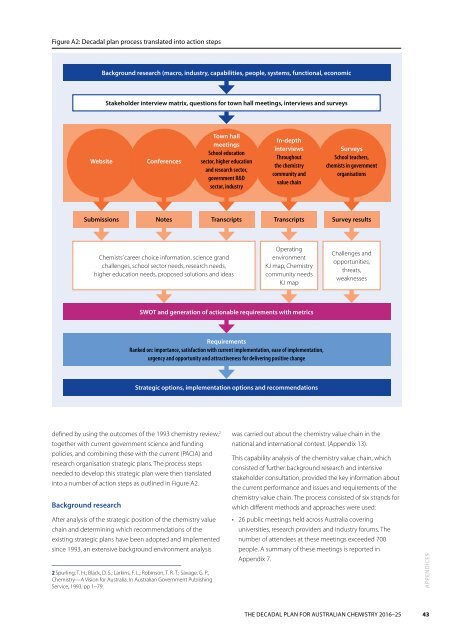Chemistry for a better life
1OiFLmD
1OiFLmD
You also want an ePaper? Increase the reach of your titles
YUMPU automatically turns print PDFs into web optimized ePapers that Google loves.
Figure A2: Decadal plan process translated into action steps<br />
Background research (macro, industry, capabilities, people, systems, functional, economic<br />
Stakeholder interview matrix, questions <strong>for</strong> town hall meetings, interviews and surveys<br />
Website<br />
Conferences<br />
Town hall<br />
meetings<br />
School education<br />
sector, higher education<br />
and research sector,<br />
government R&D<br />
sector, industry<br />
In-depth<br />
interviews<br />
Throughout<br />
the chemistry<br />
community and<br />
value chain<br />
Surveys<br />
School teachers,<br />
chemists in government<br />
organisations<br />
Submissions Notes Transcripts Transcripts<br />
Survey results<br />
Chemists’ career choice in<strong>for</strong>mation, science grand<br />
challenges, school sector needs, research needs,<br />
higher education needs, proposed solutions and ideas<br />
Operating<br />
environment<br />
KJ map, <strong>Chemistry</strong><br />
community needs<br />
KJ map<br />
Challenges and<br />
opportunities,<br />
threats,<br />
weaknesses<br />
SWOT and generation of actionable requirements with metrics<br />
Requirements<br />
Ranked on: importance, satisfaction with current implementation, ease of implementation,<br />
urgency and opportunity and attractiveness <strong>for</strong> delivering positive change<br />
Strategic options, implementation options and recommendations<br />
defined by using the outcomes of the 1993 chemistry review, 2<br />
together with current government science and funding<br />
policies, and combining these with the current (PACIA) and<br />
research organisation strategic plans. The process steps<br />
needed to develop this strategic plan were then translated<br />
into a number of action steps as outlined in Figure A2.<br />
Background research<br />
After analysis of the strategic position of the chemistry value<br />
chain and determining which recommendations of the<br />
existing strategic plans have been adopted and implemented<br />
since 1993, an extensive background environment analysis<br />
2 Spurling, T. H.; Black, D. S.; Larkins, F. L.; Robinson, T. R. T.; Savage, G. P.,<br />
<strong>Chemistry</strong>—A Vision <strong>for</strong> Australia. In Australian Government Publishing<br />
Service, 1993; pp 1–79.<br />
was carried out about the chemistry value chain in the<br />
national and international context. (Appendix 13).<br />
This capability analysis of the chemistry value chain, which<br />
consisted of further background research and intensive<br />
stakeholder consultation, provided the key in<strong>for</strong>mation about<br />
the current per<strong>for</strong>mance and issues and requirements of the<br />
chemistry value chain. The process consisted of six strands <strong>for</strong><br />
which different methods and approaches were used:<br />
• 26 public meetings held across Australia covering<br />
universities, research providers and industry <strong>for</strong>ums. The<br />
number of attendees at these meetings exceeded 700<br />
people. A summary of these meetings is reported in<br />
Appendix 7.<br />
Appendices<br />
THE DECADAL PLAN FOR AUSTRALIAN CHEMISTRY 2016–25 43


